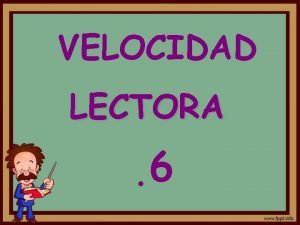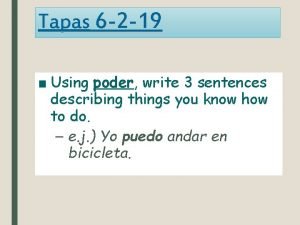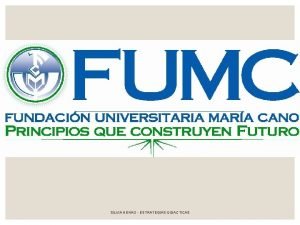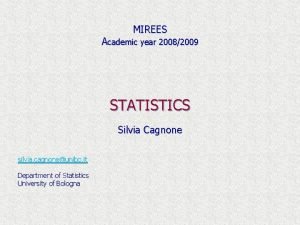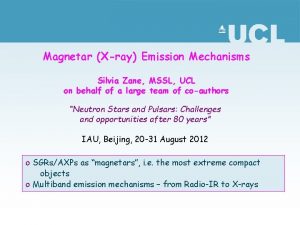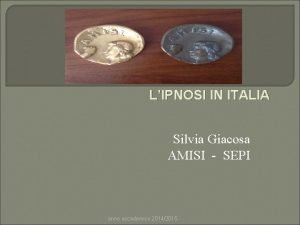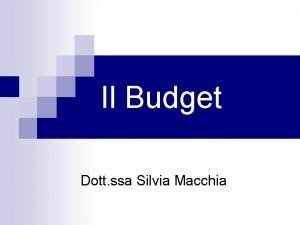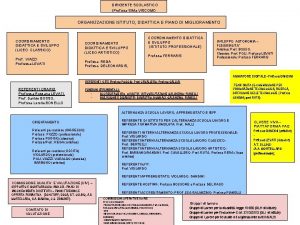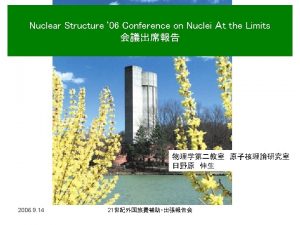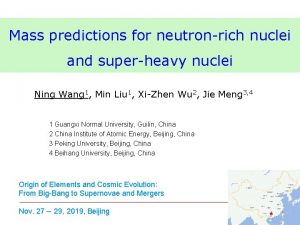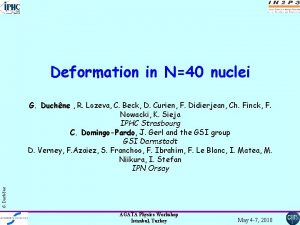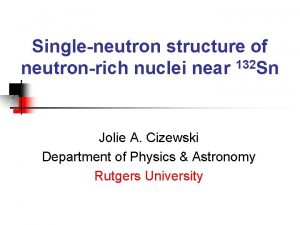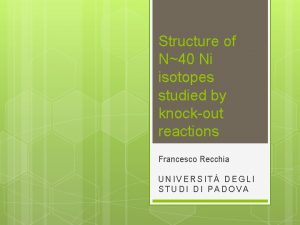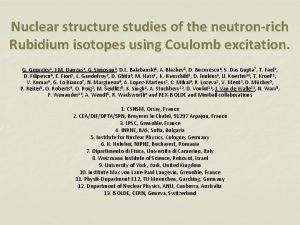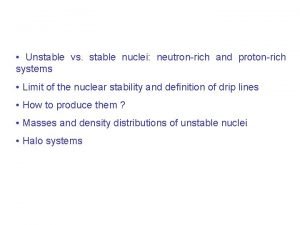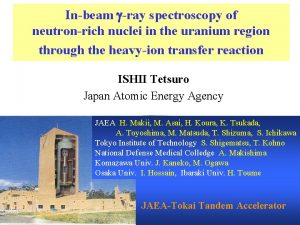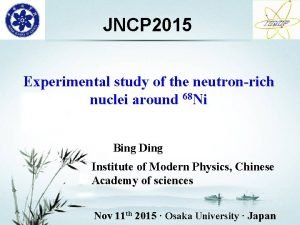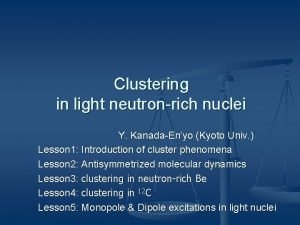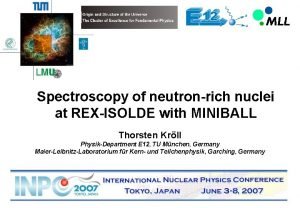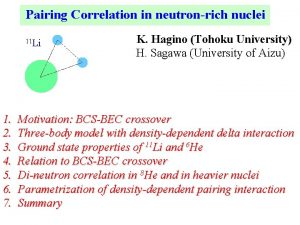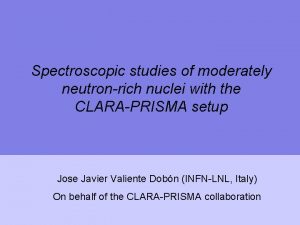Nuclear structure of neutronrich nuclei around N40 Silvia
















- Slides: 16

Nuclear structure of neutron-rich nuclei around N=40 Silvia M. Lenzi Mirror Symmetry Department of Physics and Astronomy “Galileo Galilei” University of Padua and INFN Silvia Lenzi University of– INPC Padova INFN Silvia M. Lenzi 2013, Firenze, and June 3, 2013

The physics of neutron -rich nuclei • How does the shell structure change far from stability? • How do new regions of deformation develop at “magic” numbers? • How does the effective interaction describe shape evolution and shape coexistence? • New dynamical symmetries or new shapes? • Connection with Astrophysics Silvia M. Lenzi – INPC 2013, Firenze, June 3, 2013 2

The effective interaction A multipole expansion monopole Multipole - represents a spherical mean field extracted from the interacting shell model - determines the single particle energies or ESPE - correlations - energy gains 3 Silvia M. Lenzi – INPC 2013, Firenze, June 3, 2013 Deformation

Interplay: Monopole and Multipole The interplay of the monopole with multipole terms, like pairing and quadrupole, determines the different phenomena we observe. In particular, far from stability new magic numbers appear and new regions of deformation develop giving rise to new phenomena such as islands of inversion, shape phase transitions, shape coexistence, haloes, etc. 4 Silvia M. Lenzi – INPC 2013, Firenze, June 3, 2013

The islands of inversion (N=8, 20, 28) At N=8 and N=20 the h. o. shell gap vanishes for very neutron rich nuclei. N=8 Deformed intruder configurations fall below the spherical ones N=20 Si N=28 42 Si Island of inversion 5 T. Otsuka EPJ S. Top. 156, 169 (2008) A. Poves, 2011 Silvia M. Lenzi – INPC 2013, Firenze, June 3, 2013

Neutron excess and shell migration ng 9/2 40 Monopole shifts nf 5/2 np 1/232 np 3/2 neutrons pf 7/2 A new Island of Inversion appears at N=40 Z = 28 0 g 9/2 40 0 f 5/2 1 p 1/2 1 p 3/2 28 protons 0 f 7/2 neutrons protons 0 g 9/2 0 f 5/2 Z = 20 32 28 protons 0 f 7/2 1 p 1/2 1 p 3/2 0 f 7/2 neutrons Silvia M. Lenzi – INPC 2013, Firenze, June 3, 2013

Shape changes along isotopic chains 58 Cr 56 Cr 64 Cr We populate these nuclei with different experimental methods Beta decay: O. Sorlin et al. , EPJA 16, 55 (2003) Multinucleon transfer: N. Marginean et al. , PLB 633, 696 (2006) S. Zhu et al. , PRC 74, 064315 (2006) (p, p. ): N. Aoi et al. , PRL 102 012502 (2009) Inelastic scattering: A. Gade et al. , PRC 81, 051304(R) (2010) Recent plunger experiment at MSU to measure the lifetimes and test the E(5). Silvia M. Lenzi – INPC 2013, Firenze, June 3, 2013

At and beyond N=40 g 9/2 N=40 40 fp Prisma N=42 Clara SML et al. , LNL Ann. Rep. 2008 The fpg model space is not able to reproduce the increase of collectivity of Cr and Fe isotopes approaching N=40 Silvia M. Lenzi – INPC 2013, Firenze, June 3, 2013

Islands of inversion and symmetries 12 Be N=2 8 d 5/2 s 1/2 8 p pseudo SU 3 N=1 32 Mg N=3 20 20 sd N=2 quasi SU 3 p 3/2 f 7/2 Islands of Inversion at the magic numbers can be understood in terms of symmetries 64 Cr quasi SU 3 N=4 40 40 pseudo SU 3 d 5/2 g 9/2 quasi SU 3 pseudo SU 3 pf N=3 A. P. Zuker et al. , PRC 52 (1995) Silvia M. Lenzi – INPC 2013, Firenze, June 3, 2013

Deformation and SM in the fpgd space LNPS interaction: renormalized realistic interaction + monopole corrections 48 Ca core protons: full pf shell neutrons: p 3/2, f 5/2, p 1/2, g 9/2, d 5/2 f 5/2 p 1/2 p 3/2 f 7/2 d 5/2 g 9/2 28 fp-gds gap 40 28 48 Ca π ν Note: the ground-state deformation properties result from the total balance between the monopole and the correlation energies 10 N=40 SML, F. Nowacki, A. Poves and K. Sieja (LNPS), PRC 82, 054301 (2010) Silvia M. Lenzi – INPC 2013, Firenze, June 3, 2013

The N=40 isotones A change of structure is observed along the isotonic chain in good agreement with the available data Occupation of intruder orbitals and percentage of p-h in g. s. configurations B(E 2; 2+ 0+) 11 LNPS, PRC 82, 054301 (2010) Silvia M. Lenzi – INPC 2013, Firenze, June 3, 2013

Shape coexistence in 67 Co and 68 Ni 67 Co (11/2 -) 1613 680 491 2273 (9/2 -) The deformation driven by the neutrons induces a reduction of the Z=28 gap and gives rise to a deformed low-lying 1/2 - state (3/2 -, 5/2 -) (1/2 -) (7/2 -) F. Recchia et al. , PRC 85, 064305 (2012) D. Pauwels et al. , PRC 78, 041307 (2008) and PRC 79, 044309 (2009) The LNPS interaction is able to reproduce these structures Silvia M. Lenzi – INPC 2013, Firenze, June 3, 2013

Shape coexistence in 67 Co Up to 11 p-11 h excitations across the N=40, Z=28 gap 68 Ni 03+ ~2200 2+ 2034 the largest B(E 2) in the region 0+ F. Silvia Recchia et–al. , PRC 064305 (2012) M. Lenzi INPC 2013, 85, Firenze, June 3, 2013

Beyond Z=28: Zn isotopes with AGATA at LNL Lifetimes obtained with the RDDS method LNPS calculations in very good agreement for the energies and B(E 2) Energy HFB* 2+ 0+ 4+ 2+ LNPS fpg LNPS 4+ 2+ HFB* Silvia M. Lenzi – INPC 2013, Firenze, June 3, 2013

AGATA Demonstrator at PRISMA Conclusions The mass region south of 68 Ni shows a development of collectivity towards N=40 with rapid changes of shape along the isotopic chains. A candidate for critical point of the shape phase transition, shape Thecoexistence clover array CLARA isand now phenomena the development of an Island of Inversion arethe observed experimentally for Z<28. replaced with AGATA demonstrator The LNPS effective interaction in the fpgd space is able to describe – 5 triple-clusters these rapid changes of structure along isotopic and isotonic chains. – 36 -fold segmented crystals model gives also a very good description of isotopes above Z=28. –The 540 segments The large amount of data becoming available from the different experimental facilities, with particular regard to the transition probability measurements, will be a stringent test for these theoretical predictions. Silvia M. Lenzi – INPC 2013, Firenze, June 3, 2013

Thanks to Theory: F. Nowacki, A. Poves, K. Sieja Experiments: F. Recchia, S. Lunardi, D. Bazzacco, E. Farnea, N. Marginean, J. J. Valiente-Dobon, A. Gadea, D. R. Napoli, G. de Angelis, D. Mengoni, R. Orlandi, A. Bracco, G. Benzoni, S. Leoni, B. Million, O. Wieland, J. Wrzesinski et al. H. Crawford, A. O. Macchiavelli et al. T. Baugher, A. Gade et al. C. Louchart, A. Obertelli et al. Silvia M. Lenzi – INPC 2013, Firenze, June 3, 2013
 Lesson 15 nuclear quest nuclear reactions
Lesson 15 nuclear quest nuclear reactions Fisión nuclear vs fision nuclear
Fisión nuclear vs fision nuclear Examples of what goes around comes around
Examples of what goes around comes around Goes around comes around meaning
Goes around comes around meaning Tuve que aceptar
Tuve que aceptar Themen smalltalk
Themen smalltalk Trabalenguas nadie silba como silvia
Trabalenguas nadie silba como silvia Silvia stefanova
Silvia stefanova Silvia lee a su abuelo
Silvia lee a su abuelo Silvia henao
Silvia henao Silvia consorti
Silvia consorti Statistics
Statistics Silvia zane
Silvia zane Silvia giacosa
Silvia giacosa Silvia macchia
Silvia macchia Silvia trasca
Silvia trasca Viscomi silvia
Viscomi silvia






